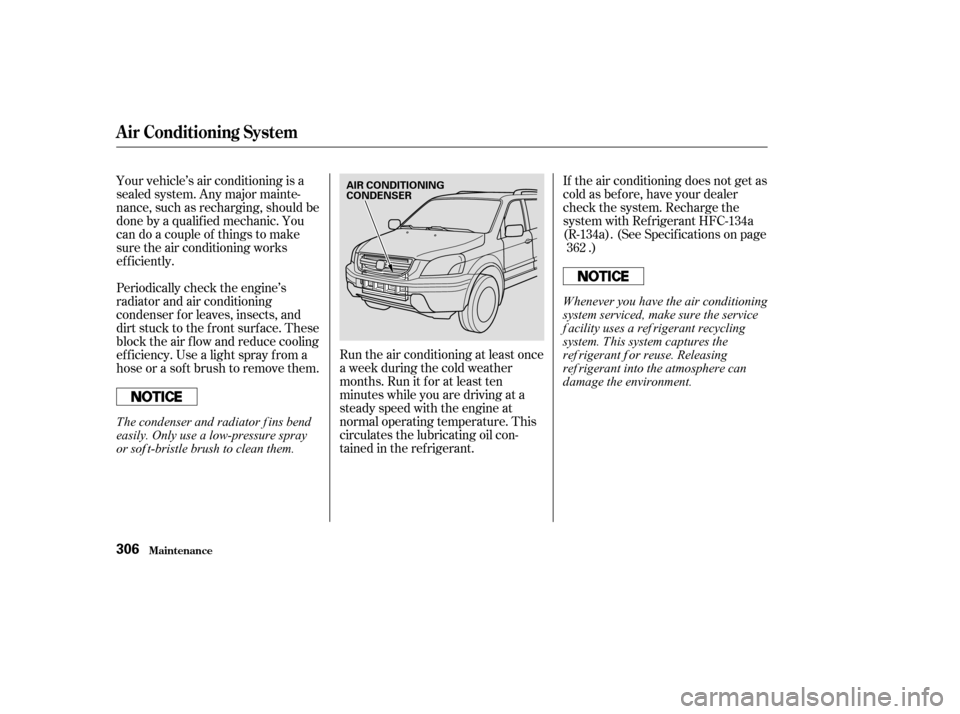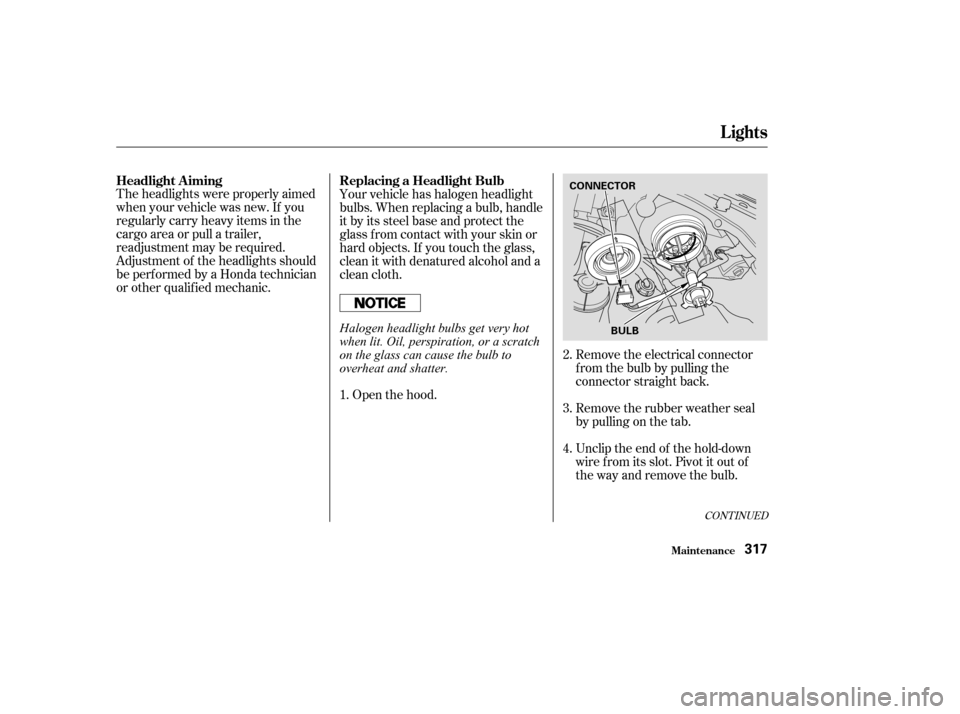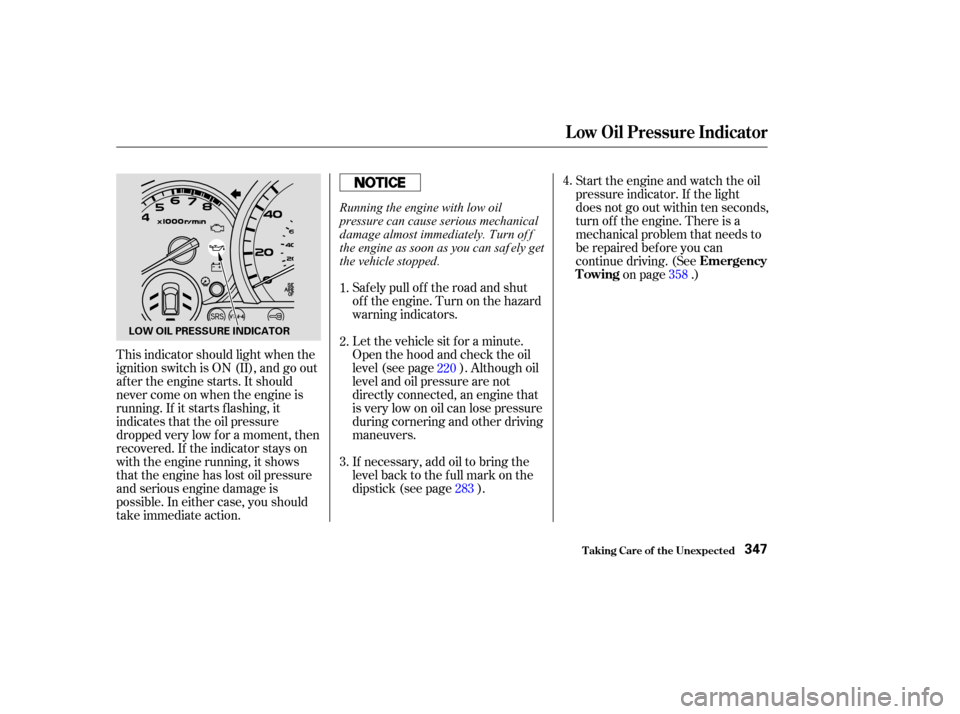Page 304 of 392
Disconnect the wire connector
f rom the ignition coil by pushing
on the lock tab and pulling on the
connector. Pull on the plastic
connector, not the wires.Remove the spark plug with
a f ive-eighths inch (16 mm) spark
plug socket. Use a wrench to remove the
hexagonsocketheadcapbolt
holding the ignition coil. Remove
the ignition coil by pulling it
straight out.Put the new spark plug into the
socket, then screw it into the hole.
Screw it in by hand so you do not
crossthread it.
4.
5.
6. 7.
Maint enance
Spark Plugs
300
HEXAGON SOCKET HEAD CAP BOLT
Page 305 of 392
�´
�µ
Torque the spark plug. (If you do
not have a torque wrench, tighten
the spark plug two-thirds of a turn
af ter it contacts the cylinder head.)
Tightening torque:Spark Plug Gap:
Install the ignition coil. Reinstall
the hexagon socket head cap bolt.
Push the wire connector onto the
ignition coil. Make sure it locks in
place.
Repeat this procedure f or the
other f ive spark plugs.
Reinstall the cover on the front
cylinder bank while putting its
mounting clip in the hole on the
passenger’s side. Secure the cover
by turning the heads of the two
holding clips one-quarter turn
clockwise with a f lat-tipped
screwdriver. NGK:
DENSO:
8. 9.
10.
11. 12. Specif ications:
Spark Plugs
Maint enance301
13 lbf·ft (18 N·m , 1.8 kgf·m)
0.04 in (1.1 mm)
PKJ16CR-L11 PZFR5F-11
0
0.1 mm
Tighten the spark plugs caref ully. A
spark plug that is too loose can
overheat and damage the engine.
Overtightening can cause damage to
the threads in the cylinder head.
Page 310 of 392

Run the air conditioning at least once
a week during the cold weather
months. Run it f or at least ten
minutes while you are driving at a
steady speed with the engine at
normal operating temperature. This
circulates the lubricating oil con-
tained in the ref rigerant.If the air conditioning does not get as
cold as before, have your dealer
check the system. Recharge the
system with Ref rigerant HFC-134a
(R-134a). (See Specif ications on page
.)
Your vehicle’s air conditioning is a
sealed system. Any major mainte-
nance, such as recharging, should be
done by a qualif ied mechanic. You
can do a couple of things to make
sure the air conditioning works
ef f iciently.
Periodically check the engine’s
radiator and air conditioning
condenser f or leaves, insects, and
dirt stuck to the f ront surf ace. These
block the air f low and reduce cooling
ef f iciency. Use a light spray f rom a
hose or a sof t brush to remove them. 362
A ir Condit ioning Syst em
Maint enance306
AIR CONDITIONING
CONDENSER
Whenever you have the air conditioning
system serviced, make sure the service
f acility uses a ref rigerant recycling
system. This system captures the
ref rigerant f or reuse. Releasing
ref rigerant into the atmosphere can
damage the environment.
The condenser and radiator f ins bend
easily. Only use a low-pressure spray
or sof t-bristle brush to clean them.
Page 321 of 392

CONT INUED
Theheadlightswereproperlyaimed
when your vehicle was new. If you
regularly carry heavy items in the
cargo area or pull a trailer,
readjustment may be required.
Adjustment of the headlights should
be perf ormed by a Honda technician
or other qualif ied mechanic.Your vehicle has halogen headlight
bulbs. When replacing a bulb, handle
it by its steel base and protect the
glass from contact with your skin or
hard objects. If you touch the glass,
clean it with denatured alcohol and a
clean cloth.
Open the hood. Remove the electrical connector
f rom the bulb by pulling the
connector straight back.
Remove the rubber weather seal
by pulling on the tab.
Unclip the end of the hold-down
wire f rom its slot. Pivot it out of
the way and remove the bulb.
1.
2.
3.
4.
Replacing a Headlight Bulb
Headlight A iming
Lights
Maint enance317
CONNECTOR
BULB
Halogen headlight bulbs get very hot
when lit. Oil, perspiration, or a scratch
on the glass can cause the bulb to
overheat and shatter.
Page 328 of 392

If you need to park your vehicle f or
an extended period (more than one
month), there are several things you
should do to prepare it f or storage.
Proper preparation helps prevent
deterioration and makes it easier to
get your vehicle back on the road. If
possible, store your vehicle indoors.Block the rear wheels.
If the vehicle is to be stored f or a
longer period, it should be
supported on jackstands so the
tires are of f the ground.
Leave one window open slightly (if
the vehicle is being stored
indoors).
Fill the f uel tank.
Change the engine oil and f ilter
(see page ).
Wash and dry the exterior
completely.
Cleantheinterior.Makesurethe
carpeting, floor mats, etc. are
completely dry.
Leave the parking brake off. Put
the transmission in Park. Support the f ront and rear wiper
blade arms with a f olded towel or
ragsotheydonottouchthe
windshield. Disconnect the battery.
To minimize sticking, apply a
silicone spray lubricant to all door
and tailgate seals. Also, apply a
vehiclebodywaxtothepainted
surfaces that mate with the door
and tailgate seals.Cover the vehicle with a
‘‘breathable’’ cover, one made
f rom a porous material such as
cotton. Nonporous materials, such
as plastic sheeting, trap moisture,
which can damage the paint.
If possible, run the engine f or a
while periodically (pref erably once
amonth).
If you store your vehicle f or 12
months or longer, have your Honda
dealer perf orm the inspections called
f or in the 24 months/30,000 miles
(48,000 km) maintenance schedule
(Normal Conditions) as soon as you
take it out of storage (see page ).
The replacements called f or in the
maintenance schedule are not
needed unless the vehicle has
actually reached that time or mileage.
285
274
St oring Your Vehicle
Maint enance324
Page 337 of 392

This section covers the more-
common problems that motorists
experience with their vehicles. It
gives you inf ormation about how to
safely evaluate the problem and what
to do to correct it. If the problem has
stranded you on the side of the road,
you may be able to get going again.
If not, you will also f ind instructions
on getting your vehicle towed.......................
Compact Spare Tire .334
....................
Changing a Flat Tire .335
..........
If Your Engine Won’t Start . 342
Nothing Happens or the Starter Motor Operates ........................
Very Slowly .342
The Starter Operates ................................
Normally .342
................................
Jump Starting .343
............
If Your Engine Overheats . 345
.........
Low Oil Pressure Indicator . 347
..........
Charging System Indicator . 348
.......
Malf unction Indicator Lamp . 349
...............
Brake System Indicator . 351
..............................................
Fuses .352
..........
Checking and Replacing . 353
......................
Emergency Towing .358
Taking Care of the Unexpected
T aking Care of t he Unexpect ed333
Page 351 of 392

This indicator should light when the
ignition switch is ON (II), and go out
af ter the engine starts. It should
never come on when the engine is
running. If it starts f lashing, it
indicates that the oil pressure
dropped very low f or a moment, then
recovered. If the indicator stays on
with the engine running, it shows
that the engine has lost oil pressure
and serious engine damage is
possible. In either case, you should
take immediate action.Saf ely pull of f the road and shut
of f the engine. Turn on the hazard
warning indicators.
If necessary, add oil to bring the
level back to the full mark on the
dipstick (see page ). Let the vehicle sit f or a minute.
Open the hood and check the oil
level (see page ). Although oil
levelandoilpressurearenot
directly connected, an engine that
is very low on oil can lose pressure
during cornering and other driving
maneuvers.Start the engine and watch the oil
pressure indicator. If the light
does not go out within ten seconds,
turn of f the engine. There is a
mechanical problem that needs to
be repaired bef ore you can
continue driving. (See
on page .)
1.
2.
3. 4.
220 283 358
L ow Oil Pressure Indicator
T aking Care of t he Unexpect ed
Emergency
Towing
347
LOW OIL PRESSURE INDICATOR
Running the engine with low oil
pressure can cause serious mechanical
damage almost immediately. Turn of f
the engine as soon as you can saf ely get
the vehicle stopped.
Page 361 of 392

�Î�Î
�Î
�µ
�µ �µ
�Î
�Î
Amps.
No. Circuits Protected
No. Amps.
Circuits Protected
15 A
10 A
7.5 A
7.5 A 7.5 A15 A
7.5 A
7.5 A 10 A
7.5 A 15 A
30 A
7.5 A
1
2
3
4
5
6
7
8
9
10
11
12
13
On Canadian models Driver’s Power Window
Driver’s Power Seat Reclining
Heated Seat
Driver’s Power Seat Sliding
Not used
Daytime Running Light
Driver’s side Rear Power
Window
Front Passenger’s Power
Window
Front Accessory Socket, Radio
Small Light
Interior Light, Navi
Power Door Lock
Back Up
Not used
Not used
Passenger’s Side Rear Power
Window
1
2
3
4
5
6
7
8
9
10
11
12
13
14
15
16 20 A
20 A
20 A
20 A
10 A
20 A
20 A
15 A
15 A
10 A
20 A
7.5 A
20 A
Fuel Pump
SRS
Heater Control, A/C Clutch
Relay, Cooling Fan Relay
Power Mirror, VTM-4
Daytime Running Light
ECU(PCM),CruiseControl
OPDS, Rear Wiper
ACC Relay
Back-up Lights, Instrument
Lights
Turn Signals
IG Coil
Front Wiper
Starter Signal
1 : Canadian models
1
Fuses
T aking Care of t he Unexpect ed357
Driver’s Side INTERIOR FUSE BOX Passenger’s Side
Front Front
: